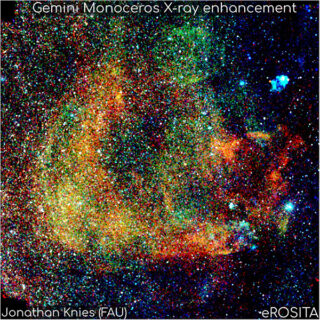Largest catalog of high-energy cosmic sources published

Stellar corpses, jets of matter and white dwarfs
Remnants of supernovae, black holes, neutron stars and the hot interstellar gas of the Milky Way and other galaxies – the sky is full of X-ray emitting sources. Researchers at the Dr. Karl Remeis Observatory, the Astronomical Institute of the Erlangen Center for Astroparticle Physics (ECAP) at FAU, used an X-ray telescope to scan the skies for such sources from 2019 until 2022 in their position as one of the leading institutes in the German eROSITA consortium. The consortium has now published the largest catalog of X-ray sources to date sources in the journal Astronomy & Astrophysics.
As many as in the 60 years before
The eROSITA X-ray telescope on board the Spektrum-RG satellite discovered approximately 900,000 X-ray sources during the first sky survey from December 2019 until June 2020. Using the telescope, researchers were able to discover more X-ray sources during this first survey than in the entire 60 years’ history of X-ray astronomy beforehand. The first eROSITA All Sky Survey Catalog (eRASS1) is therefore the largest collection of X-ray sources ever published. After processing and calibrating the collected data, the researchers created the catalog by detecting concentrations of photons in the sky against a bright, large-scale, diffuse background.
The eRASS1 catalog covers one half of the X-ray sky and is based on the data provided by the German eROSITA consortium. It includes roughly 710,000 supermassive black holes (active galactic nuclei), more than 180,000 X-ray stars in our own Milky Way, 12,000 clusters of galaxies and a small number of other exotic sources such as X-ray emitting binary stars, supernova remnants, pulsars and other objects. “The data that are now available to the global scientific community will revolutionize our knowledge about the high-energy universe,” says Prof. Manami Sasaki, Professor of Multiwavelength Astronomy at FAU. Russian scientists are responsible for analyzing the other half of the data.
The first publication of eRASS data not only includes the catalog of sources, it also contains images of the X-ray sky with various energies as well as lists of the individual photons that were discovered, giving their positions in the sky, energies and precise arrival times. The software required to analyze the eROSITA data is also included in the publication. For many types of sources, additional data relating to other wavelengths were included in what are referred to as “value-added catalogs” containing information going beyond pure X-ray information. Together with the data, the consortium published a series of scientific publications on new findings ranging from planetary habitability studies to the discovery of the largest cosmic structures.
Insights into the X-ray sky
The scientists from FAU gained fascinating insights into the X-ray sky. Federico Zangrandi, a doctoral candidate at the Dr. Karl Remeis Observatory, the Astronomical Institute at FAU, investigated the remnants of dying stars, known as supernova remnants, in the Large Magellanic Cloud. It is the largest satellite galaxy of our Milky Way. “We discovered a great number of new supernova remnants in the Large Magellanic Cloud, especially in its periphery. This indicates that stars are either being catapulted out of the cloud or are being pulled out as a result of tidal interaction between it and the Milky Way.”
Aafia Zainab is investigating the X-rays emitted by neutron stars and black holes in the Milky Way. “These sources are created in the supernova explosion during the final evolutionary stages of massive stars,” explains the doctoral candidate. Thanks to eROSITA, we were able to identify dozens of new sources such as these.” The doctoral candidate Philipp Weber is also interested in stellar corpses, but he concentrates on other galaxies. “For the first time, eROSITA has observed thousands of known galaxies in X-ray light,” he explains. He discovered sources of radiation in these galaxies that are capable of reaching intensities hundreds of thousands of times brighter than our Sun. “These sources are extremely rare, only a small percentage of galaxies contain sources such as these.”
Many galaxies are centered around a black hole with many millions times the mass of our Sun. These are known as blazars. “Such black holes can eject matter in the form of jets at speeds nearing the speed of light,” explains Steven Hämmerich, who investigates blazars in his doctoral thesis and was able to provide evidence of several thousands of these jets of matter thanks to eROSITA.
Its large field of view and high sensitivity at low X-ray energies makes eROSITA very well suited for investigating extended X-ray emissions in the sky. For the first time, researchers now have data they can use to investigate the population of X-ray sources in the satellite galaxies closest to the Milky Way. “We find white dwarfs and neutron stars in binary stars that suck up the matter from their companions,” explains Dr. Sara Saeedi, research associate at the Professorship for Multiwave Astronomy.
German-Russian satellite in hibernation
The team led by FAU astronomers Prof. Dr. Manami Sasaki and Prof. Dr. Jörn Wilms, both based at the observatory and at ECAP, was involved in developing the eROSITA X-ray telescope, a joint venture involving researchers from several German universities led by the Max Planck Institute for Extraterrestrial Physics (MPE) and the German Aerospace Center (DLR). The project was realized together with Russian researchers from the space agency Roskosmos and the Russian Academy of Sciences, represented by its Space Research Institute (IKI).
The sky was scanned a further three times between June 2020 and February 2022. The scientists have already processed some of the data and will make it available to the general public in future. The satellite has been put into safe mode since February 2022, and has not been used for scientific operations since.
Further information:
Dr. Sara Saeedi
Professorship for Multiwavelength Astronomy
sara.saeedi@fau.de
Prof. Dr. Manami Sasaki
Professorship for Multiwavelength Astronomy
manami.sasaki@fau.de
Professor Jörn Wilms
Chair of Astronomy and Astrophysics
joern.wilms@fau.de